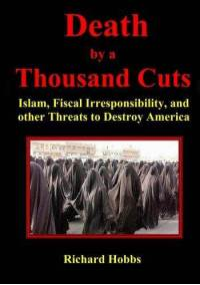 Review by James L. Abrahamson, Contributing Editor
Review by James L. Abrahamson, Contributing Editor
Richard Hobbs, Death by a Thousand Cuts: Islam, Fiscal Irresponsibility, and other Threats to Destroy America, Sparks: Nevada, ColDoc Publishing, ISBN-10: 0-964-7788-8-2, 2012. 448 pp., $29.95
Death by a Thousand Cuts: Islam, Fiscal Irresponsibility, and other Threats to Destroy America takes its title from a method of Imperial Chinese torture-execution, which involved cutting a victim—sometimes over several days—until one of the cuts finally proves fatal. The book’s subtitle suggests that many such “cuts” now threaten America’s future. In fifteen chapters, Richard Hobbs provides readers an extensive analysis of developments, both foreign and domestic, that in his view threaten the United States and Western civilization: Islamic extremism; fiscal irresponsibility; immigration policy; changes in the world order; growth of the global population; and vulnerability to shortages of energy and fresh water. In short, this book is encyclopedic in its coverage and necessarily extensive in its research.
An extraordinary military and civilian career and several earlier books prepared Hobbs, a career army officer who retired as a colonel, to undertake this challenging task. He was graduated near the top of his West Point class in 1954. His choice to serve in the Infantry led to early training as a paratrooper, Ranger, and Pathfinder and assignment to the 82d Airborne Division. Later selection as an Olmsted Scholar opened new opportunities when he attended the University of Lyon, where he completed a doctorate. During two yearlong tours in Vietnam, Hobbs advised Vietnamese paratroopers and commanded a battalion of the 28th Infantry. Between those tours he taught international relations at West Point and later became a research associate at the Center for Strategic and International Studies. Following service in the Pentagon, Hobbs became a Politico-Military Advisor in the State Department’s Bureau of Near Eastern and South Asian Affairs.
In retirement, the author worked for Teledyne, which kept him in close touch with the departments of State, Commerce, and Defense and sent him on many trips to the Middle East, Egypt, and other parts of Africa. That background then prompted him to form his own consulting firm. To this, his latest of several books, Hobbs therefore brought a wealth of military and business experience and great insight into the state of our nation and the world.
What Hobbs characterized as “Other Threats” seem worrisome enough, but he begins his book with “The Islamic Threat,” to which he devotes half his effort. Describing Islam as interpreted by the Islamists—Muslims sometimes described as extremists, fundamentalists, radicals, or jihadis—he emphasizes their efforts to extend and impose their religious and political views globally. To that end, Hobbs describes the life and cult of Muhammad, the less sympathetic aspects of the Quran and its supporting Hadith, and the Islamic military expansion known as the First Jihad. Though this harsh but justified assessment of the “Real Islam” might disappoint sympathetic Westerners and moderate Muslims hopeful of adapting to secular Western societies, Islamists will feel comfortable with Islamic practices that rightfully horrify informed Americans: e.g., abuse of women to include genital mutilation, polygamy, honor killings, brutal punishments, execution of Islam’s critics and lapsed Muslims, hopes for a totalitarian government based upon sharia law under a new caliph (deputy of God), and use of subterfuge, terror, and war to that end.
To challenge such beliefs, truly moderate Muslims would have to reject a great part of the Islamic scriptures and the Islamists’ political program. To reform Islam they also need to apply modern textual analysis to the Quran, the Hadith, and the Sunna, even though that would make them vulnerable to attack as apostates and worthy of death at the hands of Islamist Muslims. If the moderates cannot risk that—and indeed create and advocate a reformed Islam—Hobbs regards them as irrelevant to the necessary effort to combat the Islamist threat to America and the West. His demand of the moderates is that they “Renounce Islam or leave.”
Except for a later chapter, “Eurabia,” which describes the well advanced progress toward the Islamization of Europe, Hobbs closes his treatment of the Islamic threat with attention to the efforts of the American wing of the Islamist Muslim Brotherhood that, in its words, aims to destroy “Western civilization from within” and make Islam “victorious over all other religions” by means, initially, of a cultural “war” and if need be by launching a violent jihad to topple an already weakened society. To raise the consciousness of American Muslims and build an elite leadership, the Brotherhood uses Islamic schools, university student associations, and a variety of broader affiliates that seek to exploit the typical American’s blind commitment to religious tolerance and fear of being called a bigot should they resist Islamist demands.
Drawing upon that Muslim elite and the institutions the Brotherhood has put in place, it will aim at indoctrinating the public with a favorable view of Islam and putting Muslims into key positions in American society. To assist that, the Brotherhood has also created media and propaganda organizations that aim to win increasing concessions for Muslims by creating a favorable view of Islam in the minds of the general public. When it senses weakened resistance to the Islamist program, the Brotherhood intends to begin secret military training, applying political pressure, and if need be confronting the government. Only in the last stage, will it resort to violence in the belief that Islam can conquer the world if it first defeats the United States.
Informed Americans will be aware of most of the other “cuts” that Hobbs identifies as contributing to the possible “death” of the United States. Events in North Africa across the Middle East and South Asia and extending to China have put the world in a state of turmoil—“a Crucible of Crisis and Conflict”—that American presidents must keep from boiling over. China’s growing economic importance, search for water and fossil fuels, restive religious and ethnic minorities, modernizing military forces, and aggressive attitudes toward its neighbors and former satellite states make that country a special danger and justify greater U.S. attention to Pacific developments that are creating a “New World Order.”
Dealing with those challenges, as well as al Qaeda in Africa and Hugo Chavez in Latin America, has become difficult in part because of America’s “Fiscal Irresponsibility.” Reducing a national debt rivaling the U.S. annual gross domestic product, drawing down unfunded liabilities of more than a hundred trillion dollars, controlling seemingly uncontainable healthcare costs, and dealing with a huge, demanding, and too often inept government work force with great influence over office holders will make it difficult for any president to meet the global challenges identified by Hobbs, who also addresses the baneful influence of illegal immigration.
Hobbs gives special attention to the harmful consequences of tolerating “amnesty,” “birthright citizenship,” and “anchor babies,” maintaining that all immigrants must learn English and assimilate. Immigrants calling for Mexico’s “re-conquest” of the American southwest and the many criminal gangs that have entered the U.S. from Latin America have created two additional immigration problems that Hobbs believes must be vigorously countered.
Meeting two other challenges—the need to achieve energy independence and obtain sufficient fresh water for the world’s growing economy and population—appear easy only by comparison. Hobbs nevertheless boldly confronts both. Those who object to his recommendations should give careful attention to alternative approaches; doing nothing is not a viable option.
If Death by a Thousand Cuts has a weakness it is surely the number of subjects Hobbs covers and the extent of the research that he packs into every chapter. Each of the book’s fifteen chapters could easily stand on its own as a complete essay. He nevertheless wants readers to acknowledge the dangers the U.S. faces. Combined into a book of more than four hundred large pages with very narrow margins, their total effect can be almost overwhelming. In the present domestic political atmosphere, some readers will also likely take offense at several of the author’s positions.
Despite those cautions, this reviewer urges readers to set aside predetermined views, contemplate the challenges defined by the book, and aided by Hobbs’ research and reasoning determine for themselves how they believe the United States can best respond to each threat. Accept Hobbs’ facts and arguments—or not. If not, use them to design equally effective alternatives to the author’s recommendations.
The United States exists in a troubled world even as it must deal with severe domestic problems of its own making. Only an educated public can support our president and Congress in turning aside “cuts” that will otherwise drain America’s vitals.![]()
American Diplomacy is the Publication of Origin for this work. Permission to republish is freely granted with credit and a link back to American Diplomacy

